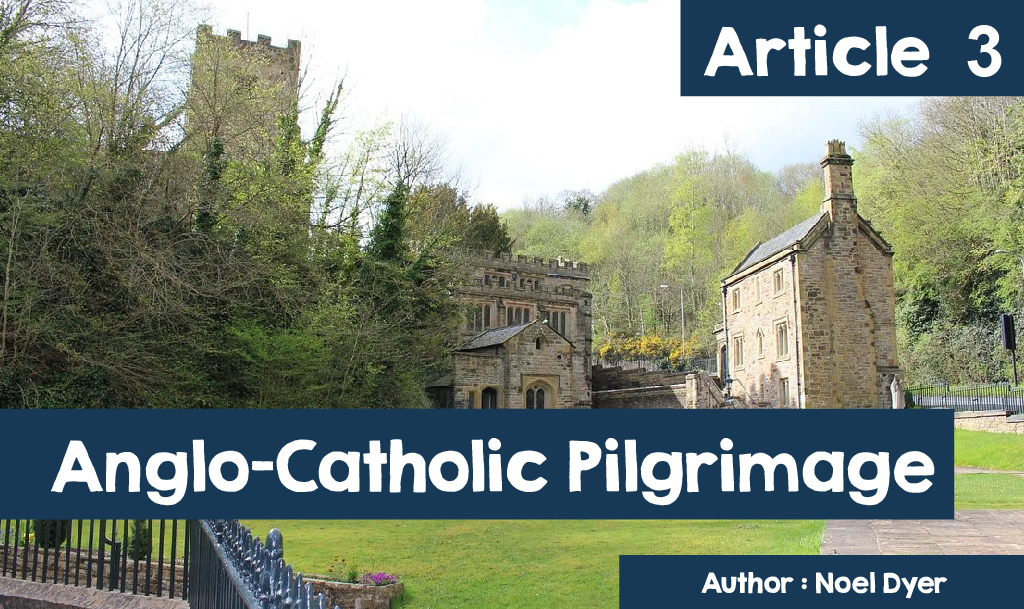Anglo-Catholic Pilgrimage
Think of religious centres in Wales. What comes to mind?
• St. Davids;
• Bardsey Island;
• Home of Bishop William Morgan near Betws y Coed;
• Home of William Williams, Pantycelyn near Llandovery;
• St.Non’s Chapel (mother of St.David).
What do these have in common? Well! They are all in West Wales. What about places in the East? There must be places of importance there too.
Two important religious centres in East Wales are Holywell in Flintshire and Penrhys in the county of Rhondda Cynon Taf.
Both these places are sometimes described as Anglo-Catholic because they have strong Anglican and Catholic connections.
Holywell / Treffynnon

Map showing location of Holywell / Treffynnon
Holywell is a small town in North East Wales. It has been an important centre of pilgrimage since the Middle Ages. It became famous as the site of St.Winefride’s
Well and chapel. It has been a centre of pilgrimage for Catholics, Anglicans and others for centuries.
The story of Winefride (Gwenffrewi), like that of several other saints is rather unfortunate. She lived in the 7th century and was a niece of St.Beuno.
Prince Caradog fell in love with Winefride but she rejected him. As a result he cut off her head but by means of a miracle St.Beuno saved her life.
A spring of water appeared where her life was miraculously restored.
In time pilgrims came to the well. A special building was erected on the order of Margaret Beaufort, mother of Henry Tudor (later crowned Henry VII).
This was between 1490 and 1500 C.E. The buildings there to this day are striking. The spring water is in a vessel shaped like a star with surrounding pillars.
Near the well is an ancient chapel, restored over the years.
Nearby too is a church. The whole site has been described as one of The Seven Wonders of Wales.

‘Lourdes of Wales’
Kristoffer Hughes
(https://www.cardiffcathedral.org.uk/penrhys/)
Some have described Holywell as the ‘Lourdes of Wales’ which underlines its importance as a pilgrimage centre.
People have travelled there since the 7th Century and do so until today. On going there people will:
• Bathe in the water of the well. Tents can be seen around the outer pool for changing.
The S4C programme Cynefin showed one of the presenters doing so. Iestyn Jones conversation with Roberta Owen from Holywell emphasised that pilgrims have been coming here for 1,300 years. 30,000
still visit every year and there are many stories claiming miraculous healings as a result!
• Pilgrims bathe three times in the outer pool. This can be done in the inner pool also.
• Nearby is the Stone of Beuno where it is said St.Beuno instructed Winefride. Here pilgrims kneel as they complete their devotions.
• Some will fill bottles with holy water from the well and light candles as they pray.
• According to one visitor on Tripadviser: ‘A lovely place to visit.
We bathed in the healing waters which was wonderful and very spiritual. Full of history and religious meaning – really worth while’.

‘Lourdes Cymru’
(© chestertouristcom https://www.geograph.org.uk/photo/219187)
Penrhys

Location of Penrhys
(Bing Maps | https://www4.bing.com/maps?FORM=Z9LH2)
Penrhys is a village in Rhondda Cynon Taf. It stands on a hill a thousand feet up between the the valleys of Rhondda Fawr and Rhondda Fach,
to the north west of Cardiff. Penrhys is noted for two things: a huge council estate with its various social problems and as a centre of pilgrimage.
The story of Penrhys as a Christian centre goes back a long way. It became famous following alleged sightings of the Virgin Mary followed by the miraculous
appearance of a statue of her in the 13th Century. It is claimed that a spring of water appeared which had healing powers. By the Middle Ages there was a monastery there,
a shrine to the Virgin Mary and a chapel for prayer.
There were stories of people being miraculously healed in the waters of the well. The water was
considered especially good for arthritis and problems with vision. When the Protestant Reformation came, the shrine was destroyed, including the statue of Mary.
There has been much restoration in the 20th Century including a new statue of Mary in 1953.

Sculpture of Mary and the Well
(Heather Cowper Flickr | August Schwerdfeger WIKIPEDIA)
Despite its long and troubled history, Penrhys remains important for Catholics, Anglicans and other Christians.
There has been a revival in interest. As a result, pilgrimages are organised from Cardiff; from Llandaf Cathedral specifically.
This is how the site is described on the pilgrimage website:
http://www.penrhyspilgrimageway.wales/
‘The route follows public rights of way for 21 miles from Llandaff Cathedral in Cardiff to Penrhys in the Rhondda.
It is divided into six parts and can be accessed by public transport at several points. It can be walked in sections or,
with an overnight stop in Llantrisant, over two days.
The route passes through or near many places of interest – and don’t forget to print a passport and collect all eleven specially-designed stamps along the way!’

Penrhys Pilgrimage Way
(http://www.penrhyspilgrimageway.wales | www.walesonline.co.uk)


